GEOCHEMISTRY OF ASPHALTENES AND BIOMARKER HYDROCARBONS IN BITUMENS OF PRECAMBRIAN AND LOWER CAMBRIAN OF THE NEPA-BOTUOBA ANTECLISE (SIBERIAN PLATFORM)
Конторович А.Е.1, Борисова Л.С.2, Тимошина И.Д.3, Чеканов В.И.4
1Доктор геолого-минералогических наук, профессор, 2кандидат геолого-минералогических наук, доцент, 3кандидат геолого-минералогических наук, институт нефтегазовой геологии и геофизики СО РАН им. Трофимука, 4кандидат геолого-минералогических наук, Всероссийский Научно-исследовательский Геологический Институт имени А.П. Карпинского
ГЕОХИМИЯ АСФАЛЬТЕНОВ И УГЛЕВОДОРОДЫ БИОМАРКЕРЫ В БИТУМАХ ДОКЕМБРИЯ И НИЖНЕГО КЕМБРИЯ НЕПСКО-БОТУОБИНСКОЙ АНТЕКЛИЗЫ (СИБИРСКАЯ ПЛАТФОРМА)
Аннотация
Сравнительное изучение асфальтенов битумов юго-востока Непско-Ботуобинской антеклизы (Сибирская платформа) методами ЯМР-, ЭПР-, ИК-спектроскопии, элементного и рентгеноструктурного анализа показало, что асфальтены асфальтов содержат меньше водорода и больше кислорода по сравнению с мальтами, в их молекулярной структуре больше степень ароматичности и меньше степень замещенности ароматических структур, алифатические заместители представлены более короткими алкановыми цепочками. На уровне надмолекулярной организации асфальтены асфальтов более компактны.
Насыщенные углеводороды изученной коллекции битумов НБА характеризуются следующими общими чертами: высокие содержания 12-, 13-монометилалканов; распределение трицикланов с преобладанием С23. Эти характеристики свидетельствуют о генетическом единстве нефтей и битумов НБА. Несколько образцов битумов обеднены этилхолестанами и гомогопанами С35, обогащены гопанами. Причиной изменения в соотношениях групп терпанов могут быть миграционные процессы или биодеградация. Биодеградация также могла быть причиной снижения отношений C29/C27 в стеранах и С35/С34 в гопанах, однако такой же результат могла дать фильтрация углеводородов в карбонатные коллекторы с низкой проницаемостью.
Ключевые слова: битумы, углеводороды биомаркеры, асфальтены, Непско-Ботуобинская антеклиза.
Kontorovich A. E.1, Borisova L. S.2, Timoshina I. D.3, Chekanov V. I.4
1Doctor of Geological and Mineralogical Sciences, professor, 2candidate of geological-mineralogical sciences, associate professor, 3candidate of geological-mineralogical sciences, Trofimuk Institute of Petroleum Geology and Geophysics SB RAS, 4candidate of geological-mineralogical sciences, Karpinsky Russian Geological Research Institute
GEOCHEMISTRY OF ASPHALTENES AND BIOMARKER HYDROCARBONS IN BITUMENS OF PRECAMBRIAN AND LOWER CAMBRIAN OF THE NEPA-BOTUOBA ANTECLISE (SIBERIAN PLATFORM)
Abstract
Comparative study of bitumen asphaltenes of the Nepa-Botuoba anteclise (NBA) by methods NMR-, EPR-, IR- spectroscopy, element composition and X-ray diffraction analysis showed that asphaltenes of asphalts contain less hydrogen and more oxygen as compared with maltha, in those molecular structure the degree of aromaticity is higher, the degree of substitution of aromatic structures is lower, and aliphatic substituents are represented by shorter alkane chains. The supramolecular structure of asphaltenes of asphalts is more compact as compared to malthas.
The saturated hydrocarbons in the bitumen collection from the NBA are characterized by the following common features: high contents of 12-, 13-monomethylalkanes; distribution of tricyclanes, which are dominated by С23. These characteristics suggest the genetic identity of bitumens and oils of the NBA. Several samples of the bitumens are depleted in the content of ethylcholestane, enriched in the content of total hopanes, depleted in С35 homohopane concentrations. Migration processes or biodegradation could be responsible for variations in the ratios of terpane groups. Biodegradation could also be the reason of decrease in sterane C29/C27 and homohopane С35/С34 ratios, however, the same result could be provided by hydrocarbon migration to low-permeable reservoirs in carbonates.
Keywords: bitumens, biomarker hydrocarbons, asphaltenes, Nepa-Botuoba anteclise.
Introduction.
Naphthide saturation within the NBA has been documented quite in many studied wells, it’s only its scale that varies [1]. Hydrocarbons formation was given start to in Cambrian, however, later, at the result of iterative restructuring they were subjected to reformation, followed by hydrocarbons cross-flow to intersalt reservoirs [1]. Naphthides are known to be weakly affected by hypergenesis [1-2].
Modern methods of geochemical studies allow to develop reliable criteria for establishing of genetic relations of oils and organic matter from source-rock mass, and to determine the impact of secondary processes on naphthides composition.
Apart from traditional use of HC-constituent component of bitumoids – extractable organic matter (EOM), this work employs a detailed study of non-HC components, mainly, asphaltenes, which composition represents a sensitive indicator of oil fields formation. Over the recent decade there has been increasingly amassed the data which attest to the fact that asphaltenes not only inherit many elements of chemical composition and of structure of the kerogen that generated them [3-8], they can also become quite a reliable indicator of naphthides from their sedimentation up to destruction in pools.
In recent years, great many of publications [9-12] have been discussing the impact of biodegradation on both structure and composition of asphaltenes. This paper affords yet another attempt to evaluate the implications of biodegradation for structural peculiarities of variously oxidized asphaltenes in bitumens from the NBA. To ascertain the impact of hypergenesis on the composition of asphaltenes the paper gives study to saturated hydrocarbons which are known to be the first to be exposed to biodegradation [13].
Materials and Methods
The object of our study were asphaltenes and saturated fractions of bitumen-saturated rocks from Gazhenskaya and Danilovskaya prospects within the bounds of the NBA (Figure 1).
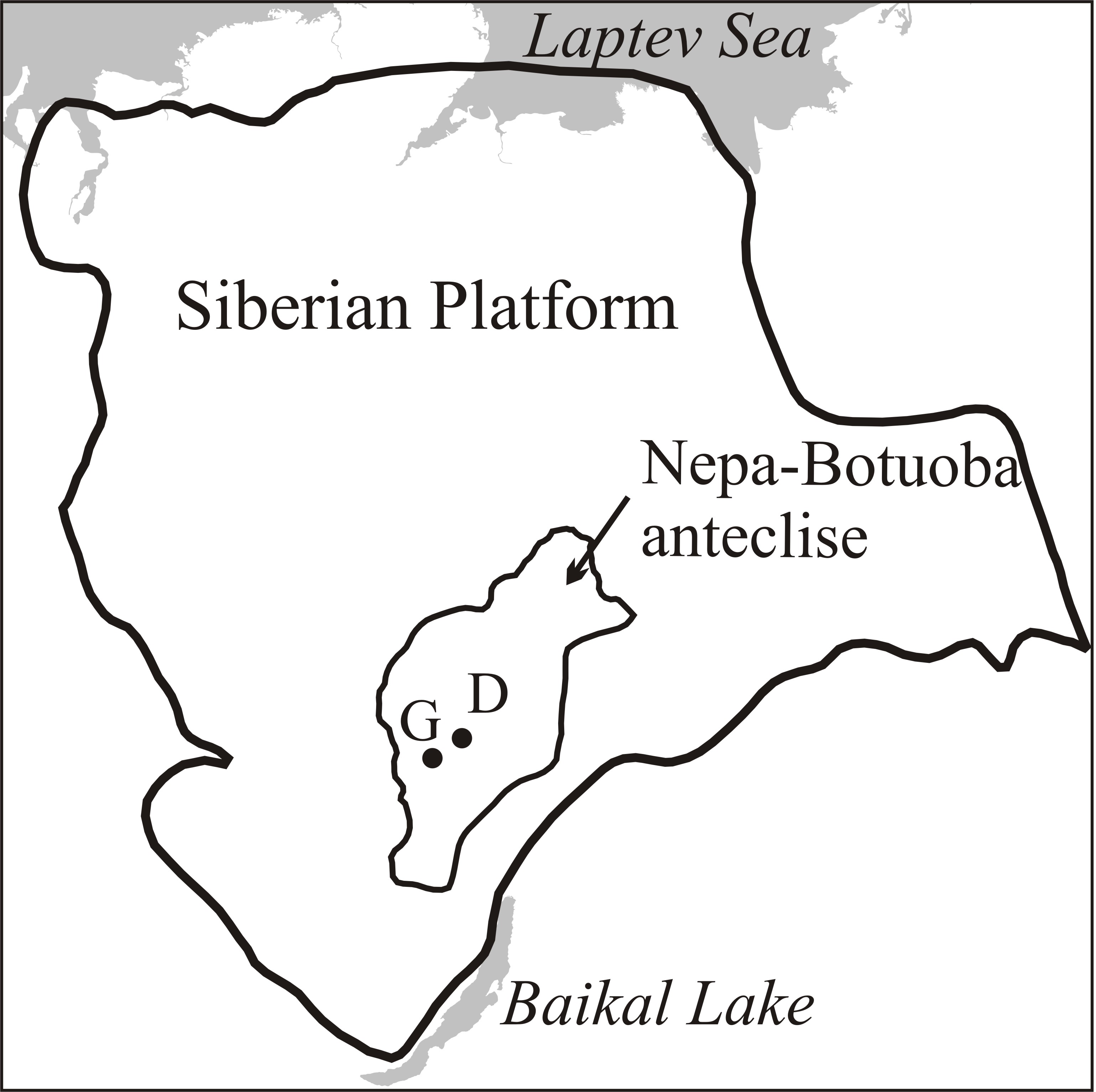
Figure 1. Location of Danilovskaya (D) and Gazhenskaya (G) prospects within the Nepa-Botuoba anteclise in Siberian platform
Extraction of bitumoids (EOM) was done with chloroform by iterated extraction method. Precipitation of asphaltenes proceeded under deployment of light petroleum (40-70ºС) in proportion 1:40 with re-precipitation. There were studied altogether 15 samples (Table 1). Asphaltenes were studied with a set of physical and physical-chemical methods according to the scheme developed earlier by A.E. Kontorovich, L.S. Borisova in their study of oils [14]. X-ray structural analysis and electron-microscopy methods were used for identification of supramolecular structure of asphaltenes, whereas spectroscopy in infrared (IR) and ultraviolet (UV) regions and radio spectrum methods were employed for the study of structural peculiarities, in particular, electron paramagnetic resonance (EPR) and nuclear magnetic resonance (NMR) in combination with traditional methods for determination of element composition.
Table 1. Examined bitumens from carbonate reservoirs
|
Sample N |
Well |
Depth, m |
Age |
Formation |
Type of bitumen |
|
G-17/538 |
Gazhenskaya-17 |
538 |
Lower Cambrian |
Bulai |
maltha |
|
G-24/698 |
Gazhenskaya-24 |
698 |
Lower Cambrian |
Bulai |
asphalt |
|
G-17/840 |
Gazhenskaya-17 |
840 |
Lower Cambrian |
Bulai |
maltha |
|
G-17/851 |
Gazhenskaya-17 |
851 |
Lower Cambrian |
Bulai |
maltha |
|
G-17/852 |
Gazhenskaya-17 |
852 |
Lower Cambrian |
Bulai |
maltha |
|
G-17/853 |
Gazhenskaya-17 |
853 |
Lower Cambrian |
Bulai |
maltha |
|
G-40/944 |
Gazhenskaya-40 |
944 |
Lower Cambrian |
Bulai |
asphalt |
|
G-138/967 |
Gazhenskaya-138 |
967 |
Lower Cambrian |
Bulai |
maltha |
|
G-65/994 |
Gazhenskaya-65 |
994 |
Lower Cambrian |
Bulai |
asphalt |
|
G-122/1007 |
Gazhenskaya-122 |
1007 |
Lower Cambrian |
Bulai |
maltha |
|
G-38/1008 |
Gazhenskaya-38 |
1008 |
Lower Cambrian |
Bulai |
maltha |
|
D-18/1623 |
Danilovskaya-18 |
1623 |
Upper Proterozoic – Lower Cambrian |
Tetere |
maltha |
|
D-18/1648 |
Danilovskaya-18 |
1648 |
Upper Proterozoic – Lower Cambrian |
Tetere |
maltha |
|
D-10/1737 |
Danilovskaya-10 |
1737 |
Upper Proterozoic – Lower Cambrian |
Tetere |
asphalt |
|
D-10/1751 |
Danilovskaya-10 |
1751 |
Upper Proterozoic – Lower Cambrian |
Tetere |
maltha |
Carbon, hydrogen and sulfur detections were carried out with CHN-analyzer. IR-spectra of asphaltenes were registered with spectrometer Specord IR-75 in the range of 400-4000 cm-1. Spectra were documented two times: in CCl4 solution and in tablets with КBr. MNR-spectra were measured with Bruker АМ-250 spectrometer. CDCl3 served as dissolvent. EPR-spectra were studied with microwave spectrometer Radiopan (λ=3cm, fmod=100 KHz) at room-temperature. A binary resonator was employed, with one of them containing fixedly placed model MgO c Mn2+ in quantitative measurements for the control of power level.
Diffraction patterns were obtained from the device Dron-1.5 (Кα С0, Fe filter) with automatic recording of intensity distribution of diffracted sample patterns for X-ray emission through the angles of diffraction. Diffraction patterns were recorded within the interval of 2θ angles ranging from 3º to 86º. The interpretation of structural features of asphaltenes was carried out by the curve of given intensity, normalized to the electronic units, from which any incoherent scattering of carbon is excluded [15].
There was observed a peak with diffraction angle 2θ = 26º, which is characteristic of coal-graphite materials (002-band) and is consistent with the reflection from condensed aromatic layers (Figure 2). This peak was superimposed by the band, conditioned by diffuse scattering, the occurrence of which, according to T. Yen et al. [16], is associated with the presence of saturated structures in aliphatic and acyclic structures. This is the so called γ-band with maximum at 2θ =19º. The authors estimated structural parameters of crystal-like associations, or features of the so called clusters [16].
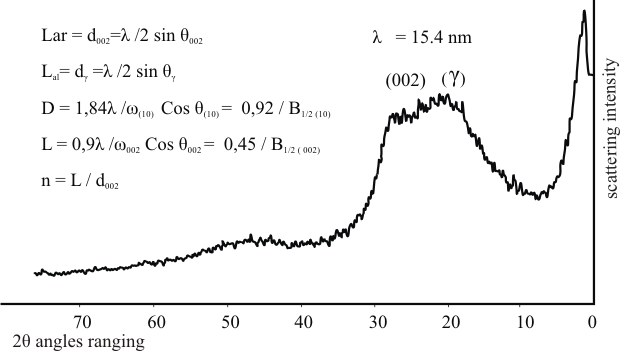
Figure 2. A typical diffraction pattern of bitumens and asphaltenes formulas of structural parameters of crystal-like associations: Lar – spacing between aromatic layers; Lal – spacing between aliphatic branches; D – diameter of condenced aromatic nuclei; L – thickness of asphaltenes particle; n – number of layers in the cluster
A scheme for asphaltenes study, along with measuring tools and environment, employed in analyses, are given a detailed account of in other works [14, 15, 17].
Saturated fraction of chloroform extracts from 21 bitumen-saturated core samples, obtained from Upper Proterozoic and Lower Cambrian rocks from the NBA, was studied with gas chromatography and chromatomass-spectroscopy (GC-MS). Distribution of HC of normal and isoprenoid structure was studied using “GC 5890” chromatograph with flame-ionization detector; whereas chromatomass-spectrum analysis was done with the “Hewlett Packard 5890” chromatograph and mass-spectroscopy (MSD 5972A) with Chem Station computer system HP G1034 for data recording and processing.
Automatic device (autosampler) AS 7673 was used for sample dosage and input; for gas-liquid chromatographic study the samples were injected with 1:50 flow separation on GC-MS, in splits-mode. The splitting was done through HP-5 fused silica columns 30 m long with internal diameter 0.25mm, the stationary phase (5% diphenyl + 95% dimethylsiloxane) being 0.25 mcm thick. Helium acted as gas-carrier. Injector temperature was 320 ºС. Temperature pattern was begun with isotherm at 100 ºС that lasted 4 min, which followed by heating up to 290 ºС at a rate 4 ºС/min, remaining persistent within 30 min. Ionizing voltage was at 70 eV, and the source temperature at 250 ºС.
GC-MS analysis was performed using the MID (multiple ion detection) mode monitoring m/z 191 fragment plus m/z 177 fragment for terpanes and m/z 217 fragment plus m/z 218 fragment for steranes and diasteranes. Identification was made by comparison of retention times of obtained fragmentograms with spectra available at the IPG SB RAS library as well as by comparison with published data.
Results and discussion
Based on the study of physical-chemical properties and hydrocarbon group analysis, bitumens are related to the traces of relatively recent migration of oil [1]. The addressed in this paper bitumens from Danilovskaya and Gazhenskaya prospects (Figure 1) are refered to as malthas and asphalts (Table 2) according to classification by V. A. Uspenskii [18].
Table 2. Bitumen classification by V. A. Uspenskii [18]
|
Content variation range, % |
Types of bitumen |
|||||
|
oil |
maltha |
asphalt |
asphaltite |
kerite |
anthraxolite |
|
|
Saturated and aromatic hydrocarbons |
100-65 |
65-45 |
45-30 |
30-5 |
5-0 |
- |
Impact of hypergenesis and increased permeability of overlying rocks during the area rises offer oils primarily to increase the proportion of heavy asphalt-resinous components.
Bitumens from Danilovskaya and Gazhenskaya prospects are represented, mainly, by malthas, which contain from 35 to 56% asphalt-resinous components. Some samples have group composition characteristic of asphalts: total content of resins and asphaltenes in them ranges from 65 to 74%, while resins’ concentration varies from 28 to 45%, and asphaltenes – from 21 to 36% per bitumen. Judging from the group analysis, hypergenesis, primarily, leads to an increase in the proportion of «acid» components, as the content of alcohol-benzene resins in malthas, on the average 2 times, and in asphalt 4 times higher than that of benzene tars. In addition, proportions inside the HC part change simultaneously with the transition from malthas to asphalts: Me-Nn fractions yield drops downs compared with Nn-Ar, and the latter dominate in the HC part already in asphalts.
The study of element content composition of asphaltenes of malthas and asphalts from the NBA ascertained that, like oil moleculars [14, 19], molecular carcass is, normally, formed of carbon atoms (85.3%, on average, for malthas and 82.6% – for asphalts). Hydrogen content in asphaltenes of malthas is, on average, higher (8.5%) as compared with asphalts (7.4%). Accordingly, atomic hydrogen to carbon ratio (1.18 vs 1.07) is higher. Asphaltenes of asphalts are characterized by relatively high concentrations of heteroatoms and, primarily, of oxygen (Figure 3).

Figure 3. Diagrams showing element composition of asphaltenes in asphalts (1: a – Gazhenskaya, well 24, the depth is 698 m; b – Danilovskaya, well 10, the depth is 1737 m) and those in malthas (2: c – Gazhenskaya, well 17, the depth is 840 m; d – Gazhenskaya, well 17, the depth is 852 m; e – Gazhenskaya, well 17, the depth is 852 m; f – Gazhenskaya, well 17, the depth is 853 m; g – Danilovskaya, well 10, the depth is 1751 m)
The content of aromatic and aliphatic structural groups and their types were defined based on NMR (nuclear magnetic resonance)-spectroscopy data (Table 3). Aromatic structures of the studied asphaltenes include from 42 to 50% of carbon atoms (on average, 42.7% in malthas vs 49.6% in asphalts). The aromatic degree of asphaltenes’molecules (Fa) asphalt is higher than that of asphaltenes of malthas: on average, 0.6 vs 0.5. Of the total number of aromatic carbon in asphaltenes of asphalts 60% account for condensation units (Carc/Car), while it averages at about 30% in asphaltenes of malthas. Total average content of aliphatic carbon is lower with asphaltenes of asphalt (33.0%) than that of malthas (42.6%), their aliphatic chains are, predominantly, shorter, and the ratio Сβγ(СН2+СН) to Сβγ(СН3) equals 1.4, unlike asphaltenes of malthas, where it averages at about 3.
Table 3. Distribution of carbon in asphaltenes of bitumen-saturated rocks of Gazhenskaya and Danilovskaya prospects from the NBA, % asphaltenes mass (mean values of NMR-spectrometry)
|
Bitumen type |
Aliphatic structures |
Aromatic structures |
Far |
Car(p)/Car |
Car(c)/ Car |
Сβγ(СH2+CH)/ Cβγ (CH3) |
||||||
|
Сα |
Сβγ (СH2+CH) |
Cβγ (CH3) |
Cal |
Сar(p) |
С(CH)ar |
Car(c) |
Сar |
|||||
|
maltha |
14.1 |
21.0 |
7.5 |
42.6 |
30.7 |
16.6 |
12.0 |
42.7 |
0.5 |
0.7 |
0.3 |
2.8 |
|
asphalt |
6.8 |
15.3 |
10.9 |
33.0 |
19.5 |
11.7 |
30.1 |
49.6 |
0.6 |
0.4 |
0.6 |
1.4 |
Note: Сα – carbon concentration in saturated groups, located in α-position to benzene ring; Сβγ – carbon concentration in saturated groups, located in β-, γ-position to benzene ring; Саr(c) – carbon concentration in condensation in condenser units of aromatic structures; Саr(p) – carbon concentration in periphery positions of aromatic structures; Far – aromaticity degree.
To quantitatively estimate the role of oxygen-containing structures of asphaltenes both in malthas and asphalts spectral ratios were calculated according to IR-spectroscopy, which depict relative content of: aromatic ethers – К1 = (1700 cm-1)/(1460 cm-1), aliphatic compound ethers – К2 = (1740 cm-1)/(1460 cm-1), acids – К3 = (1720 cm-1)/(1460 cm-1) in the studied bitumens. СН2-groups absorption bands (1460 cm-1), normally employed in IR-spectroscopy, served as reference therewith. Table 4 shows the average data. Statistically, asphaltenes of asphalts have oxygen-containing monomers in higher concentrations than asphaltenes of malthas, which is consistent with their high content of oxygen according to the results of elemental analysis.
Table 4. Mean values of IR-spectrometry for oxygen-containing compounds in asphaltenes of bitumen-saturated rocks of Danilovskaya and Gazhenskaya prospects
|
Bitumen type |
1700/1460 cm-1 |
1740/1460 cm-1 |
1720/1460 cm-1 |
|
Maltha |
0.38 |
0.07 |
0.18 |
|
Asphalt |
0.67 |
0.17 |
0.36 |
In the studied samples, the number of paramagnetic centers (PMC) estimated by EPR-spectra varies within a small range: 3.6 – 8.5*1018 g-1. It can be likened to PMC of asphaltenes [14, 19]. Apart from free radical signal on EPR spectrum of asphaltenes of malthas signal V4+ is present, which might have had a genetic link with tetrapyrrol nucleus, whereas in asphaltenes of asphalts, V4+ is absent. It can be assumed that metal complexes of porphyrins are destroyed under oxidation.
According to the X-ray structure analysis (Figure 4) bitumen asphaltenes are characterized by supramolecular structure. A supercondenced polyaromatic layer proves to be its basic unit. Average diameter of aromatic layers in asphaltenes of malthas is 1.8 nm, whereas it is somewhat higher and comes to 2.20 nm with asphaltenes of asphalts. Polycyclic layers of asphaltenes in malthas and asphalts bundle together into clusters from 1.0 to 1.8 nm thick. Moreover, the asphaltenes of malthas comprise more layers (on average, 4-5) than asphaltenes of asphalts (on average, 3).
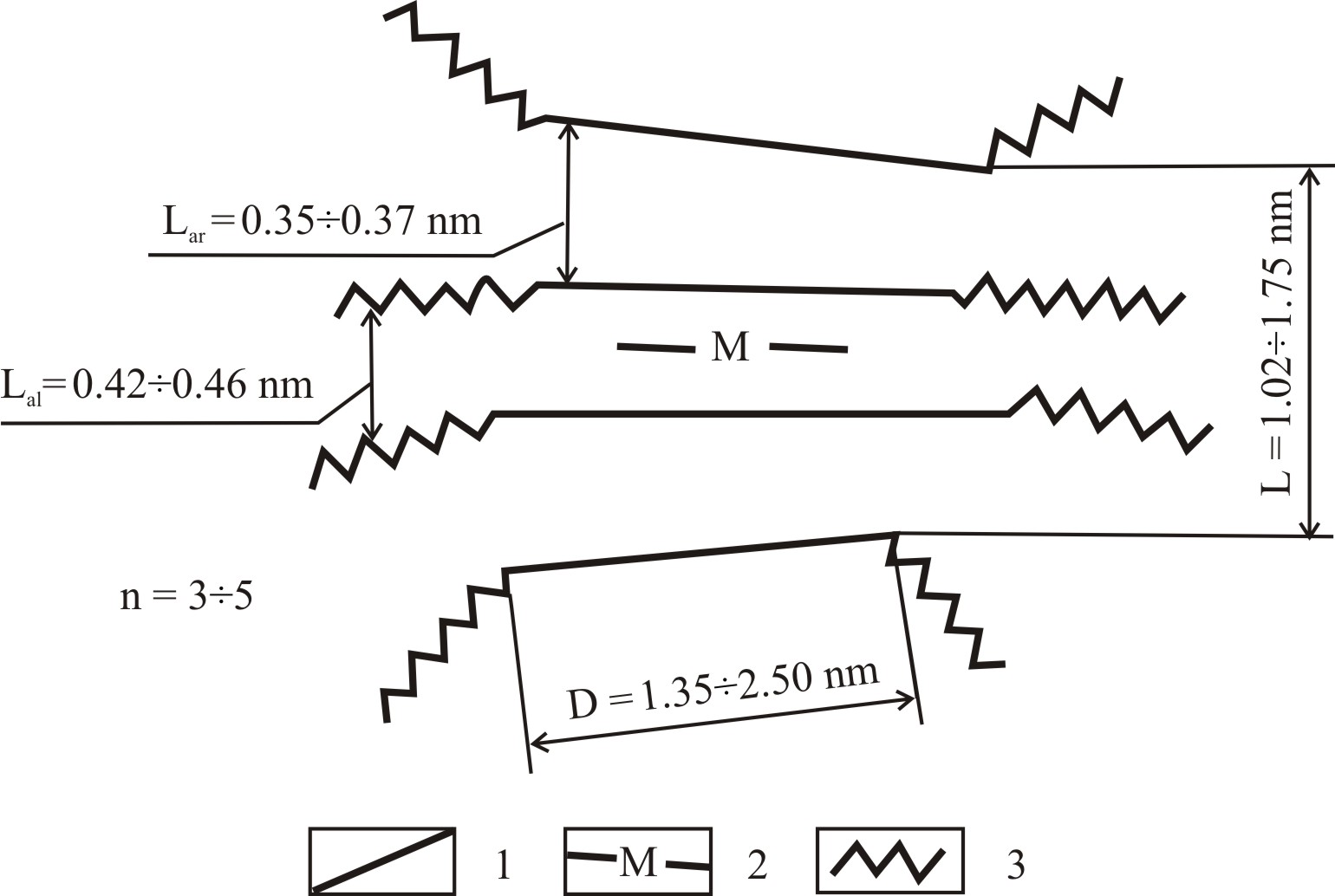
Figure 4. Hypothetical model of bitumen asphaltenes based on the data from the scheme by T.F. Yen, I.G. Erdman, C.C. Pollak [16] (1 – condenced naphtheno-aromatic nuclei; 2 – metalloporphyrin complexes; 3 – aliphatic chains; Lar, Lal, D, L, n – calculated from the formulas given in Figure 2.
Comparative study of bitumen asphaltenes showed that in terms of composition and structure they are very much alike. However, asphaltenes of asphalts contain less hydrogen and more oxygen by the elemental composition, as compared to malthas.
Minor changes occur already at the level of molecular structure: there are more oxidized bitumens in asphaltenes, higher aromatic degree and lesser degree of substitution of aromatic structures; aliphatic substituents are represented by shorter alkane chains. At the level of supramolecular structure asphaltenes of asphalts prove more compact. Asphaltenes of malthas have smaller diameter of aromatic layer than those of asphalts, though, but the layers are bigger in amount, hence, the clusters’ thickness is higher.
Non-biodegraded Precambrian – Lower Cambrian oils from NBA have a number of specific features [20-23]: they contain high concentrations of 12- and 13-monomethylalkanes (5.4-17.6%, on average 12.3% in saturated fraction); ethyl-cholestane dramatically predominate in steranes composition (on average C29/C27 > 4), represented by, mainly, regular (αα+ββ) compounds (C29βα/(αα+ββ) ≤ 2); terpanes prove to have high concentrations of tricyclanes, with C23 hydrocarbon predominating among them and tricyclane index ITС = 2C19-20/C23-26 < 1; concentrations of C35 homohopane is higher than that of C34. Besides, both saturated and aromatic fractions of these oils are abnormally enriched with light 12С isotope, and δ13С changes within the span −36.5…−33.2‰, on average −34.7‰.
The studied bitumens from Danilovskaya and Gazhenskaya wells evaluated by gas-liquid chromatography and chromato-mass spectrometry, are similar to previously studied oils from this area by a number of parameters (Figure 5, 6, 7, Table 5) (in acyclic isoprenoids Pr/Ph<1; high content of 12- and 13-monomethylalkanes (7,3-18,9% per sum of alkanes), inherent to only ancient oils and EOM (bitumoids), tricyclanes distribution with С23 predominating among them and tricyclane index being 2С19-20/С23-26<1, which attests to genetic unity of oils and bitumens in all stratigraphical complexes of the NBA; the source of these oils is supposed to have come from enriched with OM Neoproterozoic (Riphean) deposits from the Baikal-Patom center of naphthide generation [21].
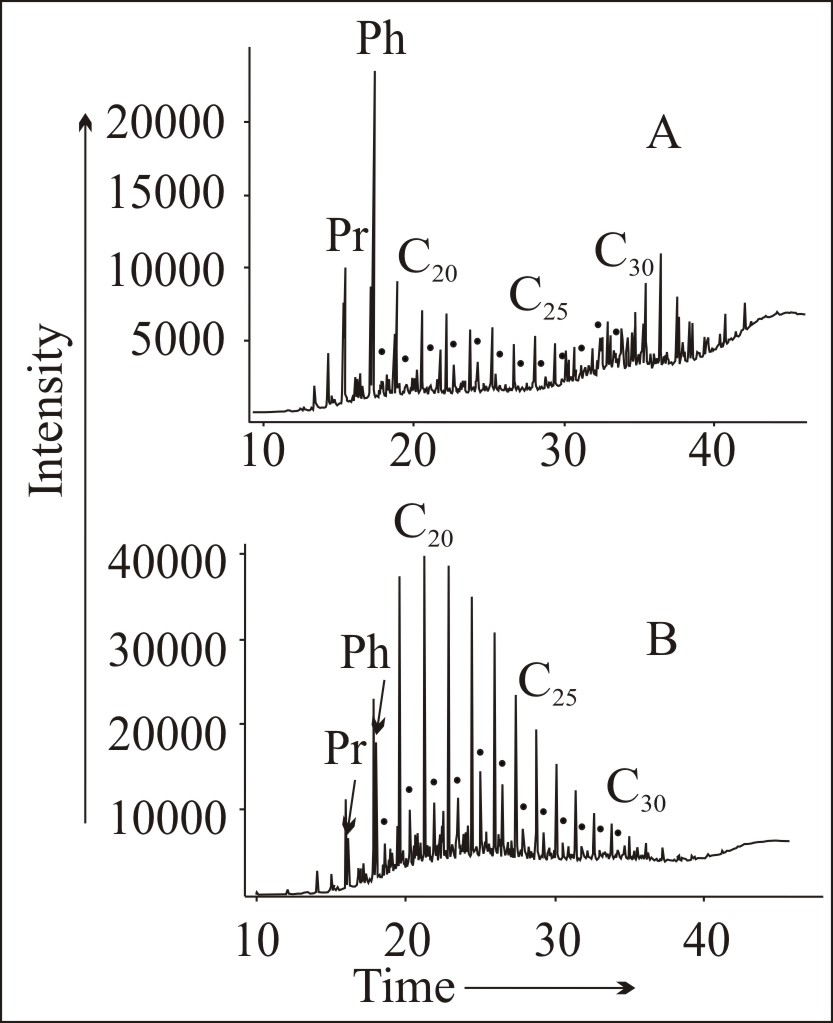
Figure 5. Chromatograms of the bitumens (A – the asphalt from the Gazhenskaya-40 well, depth 944 m; B – the maltha from the Gazhenskaya-38 well, depth 1008 m; C20, C25, C30 – number of carbon atoms in a normal alkane molecule; Pr – pristane, Ph – phytane; dots represent 12- and 13-monomethylalkanes).
Table 5. Variations in geochemical parameters of bitumens
|
Parameter |
Samples |
Non-biodegraded oils [20-23] from NBA, (spread of values)/ mean value |
|||||||
|
D-18/1648 |
D-18/1623 |
G-38/1008 |
G-122/1007 |
G-65/994 |
G-138/967 |
G-40/944 |
G-17/538 |
||
|
δ13Сsat, ‰ |
-35.0 |
-34.8 |
-34.0 |
-32.7 |
-33.7 |
-31.9 |
-32.8 |
-32.5 |
(-36.5 ÷ -33.2)/ -34.7 |
|
Pr/Ph |
0.6 |
0.6 |
0.3 |
0.5 |
0.5 |
0.5 |
0.4 |
0.6 |
(0.6÷1.2)/ 0.9 |
|
Pr/nC17 |
0.6 |
0.7 |
0.5 |
0.7 |
0.8 |
1.7 |
1.3 |
0.8 |
(0.4÷0.7)/ 0.5 |
|
Ph/nC18 |
1.3 |
1.3 |
0.8 |
1.3 |
1.5 |
3.0 |
3.0 |
1.6 |
0.1÷1.3/ 1.0 |
|
12-, 13-mma1, % |
18.9 |
18.1 |
15.5 |
7.3 |
13.5 |
9.5 |
8.5 |
8.0 |
(5.4÷17.6)/ 12.3 |
|
C29βα/ (αα+ββ)2 |
0.1 |
0.1 |
0.1 |
0.2 |
0.2 |
0.2 |
0.2 |
0.2 |
(0.1÷0.3)/ 0.1 |
|
C29/C273 |
4.9 |
4.7 |
4.6 |
1.2 |
1.6 |
1.1 |
1.2 |
1.1 |
(2.5÷5.6)/ 4.2 |
|
Ts/Tm |
0.8 |
0.5 |
0.7 |
0.9 |
0.7 |
0.6 |
0.6 |
0.9 |
(0.5÷4.0)/ 1.1 |
|
ΣH/ΣT4 |
0.9 |
1.0 |
1.2 |
7.9 |
4.1 |
15.7 |
18.4 |
9.5 |
(0.1÷1.5)/ 0.7 |
|
C35/C345 |
1.3 |
1.5 |
1.4 |
0.5 |
0.6 |
0.4 |
0.4 |
0.6 |
(1.0÷3.4)/ 1.3 |
|
ITC6 |
0.2 |
0.2 |
0.1 |
0.3 |
0.3 |
0.3 |
0.3 |
0.3 |
(0.2÷0.6)/ 0.2 |
112-, 13-mma = percentage of 12- and 13-monomethylalkanes
2C29βα/(αα+ββ) = ratio of the C29 diasteranes to the sum of C29 regular steranes
3C29/C27 = ratio of the sum of steranes C29(αα+ββ+βα) to the sum of steranes C27(αα+ββ+βα)
4ΣH/ΣT = ratio of the sum of C27-30 norhopanes, hopanes and homohopanes to the sum of C19-31 tricyclanes
5C35/C34 = ratio of the sum of homohopanes C35S and C35R to the sum of homohopanes C34S and C34R
6ITC = 2C19-20/C23-26 – ratio of the double sum of tricyclanes C19 and C20 to the sum of tricyclanes C23, C24, C25, and C26 (tricyclane index).
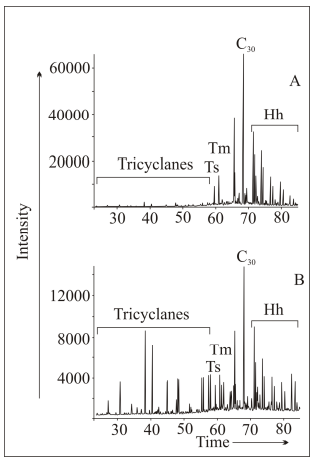
Figure 6. Mass-fragmentograms of terpanes (m/z 191) in the bitumens (A – the asphalt from the Gazhenskaya-40 well, depth 944 m; B – the maltha from the Gazhenskaya-38 well, depth 1008 m; С19-29 tricyclanes, Ts – C27 trisnorneohopane, Tm – C27 trisnorhopane, C30 – C30 hopane, Hh – С31-35 homohopanes).
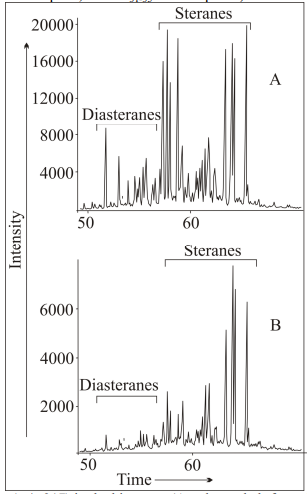
Figure 7. Mass-fragmentograms of steranes (m/z 217) in the bitumens (A – the asphalt from the Gazhenskaya-40 well, depth 944 m; B – the maltha from the Gazhenskaya-38 well, depth 1008 m; С27-28 diasteranes, С27-29 steranes).
Malthas picked up at the greatest depth (samples D-18/1648, D-18/1623, G-38/1008) reveal the composition of hydrocarbon biomarkers (Figure 5-B, 6-B, 7-B, Table 5), closest to that of the oils from the NBA not altered by biodegradation [20-23]. This is ascertained by smooth normal distribution of unbranched compounds solely peaking at nC20, high content of ethylcholestanes (C29/C27>4) and tricyclanes (ΣH/ΣT <1), and by the fact that concentration of C35 homohopane is higher than that of C34 (Table 5, Figure 5-B, 6-B, 7-B). Those same bitumens are characterized by light carbon isotope 12C (Table 5), its content being the highest and closest to oils from the NBA.
Malthas and asphalts, localized at lower depths (samples G-122/1007, G-65/994, G-138/967, G-40/944, G-17/538 from carbonate reservoirs of the Lower Cambrian Bulay Formation) are: being enriched to some extent in heavy isotope 13C (δ13С to −31.9‰), as compared to oil, which can be attributed to migration of molecules with the isotopically lightest carbon, which might be combined with biodegradation, as bacteria prefer 12C. These bitumen account for the second peak in n-alkanes in the range of nС29-33, weakly expressed and covered up among the highest peaks of hopanes (Figure 5-A), as well the concentration of 12- and 13-monomethylalkanes drop down, compared to those occurring deeper (Table 5).
Moreover, in bitumens G-122/1007, G-65/994, G-138/967, G-40/944, G-17/538 the following phenomenon are observed (Table 5, Figure 6-A, 7-A): reduction of ethylcholestane in the S27-30 steranes series; a sharp increase of the amount of hopanes compared with tricyclanes (ΣH / ΣT>> 1); a decrease in concentrations of C35 homohopanes (C35/C34 <1). The reason for changes in the groups’ ratio may as well be either migration, or biodegradation. Thus, selective accumulation of hopanes could have occurred through the increased migration of more compact molecules of tricyclanes) or through biodegradation, as disposing of aliphatic hydrocarbons, bacteria are very much likely to become a source of hopanes.
Biodegradation may have caused the reduction of C29/C27 and C35/C34 ratios; the same result could have been produced by hydrocarbons filtration in reservoirs with low permeability formed in carbonates, though. However, taking into account the results of the study of asphaltenes and unidirectional changes in asphaltenes and saturated fractions, it should be concluded that biodegradation was the main factor in variations both in hydrocarbon and isotopic composition of the studied bitumens and addressed by this paper.
Conclusions
This paper addresses the influence of biodegradation on the composition of asphaltenes and saturated hydrocarbons Lower Cambrian bitumens of Danilovskaya Gazhenskaya prospects from the NBA, based on the employed modern physical and physicochemical methods in the study done (CM-MS, NMR, EPR, IRSM, elemental, isotopic and X-ray analysis).
On the basis of several characteristics of HC-biomarkers (Pr/Ph <1, high content of 12- and 13-monomethylalkanes, distribution tricyclanes with a predominance of C23 and tricyclanes index 2C19-20/C23-26 <1) revealed genetic unity of bitumens and previously studied oils from the NBA.
The influence of bitumen biodegradation with various oxidation degree (malthas and asphalts) have been studied both through distribution of HC-biomarkers: n-alkanes, steranes, terpanes, and at the level of molecular and macromolecular structure and composition of asphaltenes.
Like petroleum asphaltenes, those of bitumens are characterized by supramolecular structure with layered structure. Polycyclic layers of asphaltenes in malthas and asphalts are associated inclusters. In asphaltenes of malthas there are 4-5 layers in a cluster, whereas in those composed of asphaltenes of asphalts - 3, on average. Asphaltenes of malthas have lesser diameter of aromatic layers, compared to asphalts. At the molecular level differences bitumen various oxidation degrees are marked by some specific features both in composition and structure: there is less hydrogen and more oxygen in asphaltenes of asphalts, as compared to malthas, and they are characterized by higher degree of aromatics and lesser amount of substituted aromatic structures, while aliphatic alternates are represented by shorter alkane chains.
Acknowledgment. The authors thank Andrei Ivanovich Larichev from Karpinsky Russian Geological Research Institute, St. Petersburg and Pyotr Nikolayevich Sobolev from Siberian Research Institute of Geology, Geophysics and Mineral Resources, Novosibirsk for providing information and sample collection, without which we would not have been able to accomplish this study.
Литература
1. Kontorovich, A.E. Location regularities of naphthides in Gazhenskaya oil and gas accumulation zone – new prospective oil exploration region / A. E. Kontorovich, A. I. Larichev, P. N. Sobolev, V. I. Chekanov // Geochemical criteria of the formation of petroleum accumulation zones in platform areas of Siberia [in Russian]. – Novosibirsk, SNIIGGiMS, 1986. – P. 4-13.
2. Kontorovich, A.E. Geochemistry of naphthide asphaltenes from the Ust-Kut horizon of the Danilov field / A. E. Kontorovich, L. S. Borisova, N. V. Smirnova // Geochemistry of oil-and-gas bearing deposits of Siberia [in Russian]. – Novosibirsk, SNIIGGiMS, 1990. – P. 3- 8.
3. Tissot, B.P. Petroleum Formation and Occurrence / B. P. Tissot, D.H. Welte. – Berlin, Springer-Verlag, 1984. – 699 p.
4. Castex, H. Resines et asphaltenes: Revolution en function des types de matiere organique et de leur enfouissement. – Institut Francais du Petrole, Ref. 25169, 1977. – 21 p.
5. Bandurski, E. Structural similarities between oil-generating kerogens and petroleum asphaltenes // Energy Source. – 1982. – Vol. 6, N 1/2. – P. 47-66.
6. Rubinstein, I. Pyrolysis of asphaltenes: a source of geochemical information / I. Rubinstein, C. Spyckerelle, O. Straus // Geochem. et Cosmochim. Acta. – 1979. – Vol. 43, N 1. – P.1-7.
7. Lehne, E. Bulk kinetic parameters and structural moieties of asphaltenes and kerogens from a sulphur-rich source rock sequence and related petroleums / E. Lehne, V. Dieckmann // Organic Geochemistry. – 2007. – Vol. 38. – P. 1657-1679.
8. Arefiev, O.A. Asphaltenes – indicators of geochemical typification of oils / O. A. Arefiev, V. M. Makushina, A. A. Petrov // Izv. USSR AS. Ser. Geol. [in Russian]. – 1980. – N 4. – P. 124-130.
9. Liao, Y. The influence of biodegradation on resins and asphaltenes in the Liaohe Basin / Y. Liao, A. Geng, H. Huang // Organic Geochemistry. – 2009. – Vol. 40. – P. 312-320.
10. Mullins, O.C. Asphaltenes, heavy oils and petroleomics / O. C. Mullins, E. Y. Sheu, A. Hammami, A. G. Marshalln. – New York: Springer, 2007. – 669 p.
11. Silva, T.F. Effect of biodegradation on biomarker released from asphaltenes / T. F. Silva, A. A. Azevedo, M. D. Rangel and others // Organic Geochemistry. – 2008. – Vol. 39, N 8. – P. 1249-1257.
12. Xiong, Y. Carbon isotopic composition of individual n-alkanes in asphaltene pyrolysates of biodegraded crude oils from the Liaohe Basin, China / Y. Xiong, A. Geng // Organic Geochemistry. – 2000. – Vol. 31. – P. 1441-1449.
13. Petеrs, K.E. The biomarker guide, vol. 2 / K. E. Petеrs, C. C. Walters, J. M. Moldowan. – Cambridge Univercity Press, 2007. – P. 475-1155.
14. Borisova, L.S. Heterocyclic components of dispersed organic matter and oils of West Siberia // Geology and Geophysics. – 2004. – Vol. 45. – N 7. – P. 884-894.
15. Borisova, L.S. Study of oil asphaltenes from West Siberian Plate with X-ray diffraction method // Organic geochemistry of the Mesozoic and Paleozoic strata of Siberia [in Russian]. – Novosibirsk, SNIIGGiMS, 1981. – P. 71-78.
16. Yen, T.F. Investigation of the structure of petroleum asphaltenes by X-ray diffraction / T. F. Yen, I. G. Erdman, S. S. Pollack // Anal. Chem. – 1961. – Vol. 33, N 11. – P. 1587-1594.
17. Kontorovich, A.E. Methodological recommendations to a study of asphaltenes foridentification of oil source rocks and quantitative estimation of the petroleum potential of deposits [in Russian] / A. E. Kontorovich, L. S. Borisova. – Novosibirsk, SNIIGGiMS, 1991. – 28 p.
18. Uspenskii, V.A. Principles of genetic classification of bitumens [in Russian] / V. A. Uspenskii, O. A. Radchenko. – Leningrad: Nedra, 1964. – 350 p
19. Borisova, L.S. Geochemistry of oil asphaltenes of Western Siberia // Geologiya nefti i gaza [in Russian]. – 2009. – N 1. – P. 74-78.
20. Petrov, A.A. Hydrocarbons of oil [in Russian] – Moscow: Nauka, 1984. – 263 p.
21. Kontorovich, A.E. Heterochronous centers of naphthide formation and accumulation in the North Asian Craton / A. E. Kontorovich, S. F. Bakhturov, A. K. Basharin et al. // Russian Geology and Geophysics. – 1999. – Vol. 40, N 11. – P. 1647-1665.
22. Timoshina, I.D. Geochemistry of organic matter of oil source rocks and oils from Upper Precambrian strata of southern East Siberia // Russian Geology and Geophysics. – 2004. – Vol. 45, N 7. – P. 852-861.
23. Kontorovich, A.E. Geochemistry of Precambrian oils of Eurasia and Australia / A. E. Kontorovich, V. A. Kashirtsev, I. D. Timoshina, N. S. Kim // Petroleum Frontiers. – 2005. – Vol. 20, N 3. – P. 11-26.
References
Kontorovich, A.E. Location regularities of naphthides in Gazhenskaya oil and gas accumulation zone – new prospective oil exploration region / A. E. Kontorovich, A. I. Larichev, P. N. Sobolev, V. I. Chekanov // Geochemical criteria of the formation of petroleum accumulation zones in platform areas of Siberia [in Russian]. – Novosibirsk, SNIIGGiMS, 1986. – P. 4-13.
Kontorovich, A.E. Geochemistry of naphthide asphaltenes from the Ust-Kut horizon of the Danilov field / A. E. Kontorovich, L. S. Borisova, N. V. Smirnova // Geochemistry of oil-and-gas bearing deposits of Siberia [in Russian]. – Novosibirsk, SNIIGGiMS, 1990. – P. 3- 8.
Tissot, B.P. Petroleum Formation and Occurrence / B. P. Tissot, D.H. Welte. – Berlin, Springer-Verlag, 1984. – 699 p.
Castex, H. Resines et asphaltenes: Revolution en function des types de matiere organique et de leur enfouissement. – Institut Francais du Petrole, Ref. 25169, 1977. – 21 p.
Bandurski, E. Structural similarities between oil-generating kerogens and petroleum asphaltenes // Energy Source. – 1982. – Vol. 6, N 1/2. – P. 47-66.
Rubinstein, I. Pyrolysis of asphaltenes: a source of geochemical information / I. Rubinstein, C. Spyckerelle, O. Straus // Geochem. et Cosmochim. Acta. – 1979. – Vol. 43, N 1. – P.1-7.
Lehne, E. Bulk kinetic parameters and structural moieties of asphaltenes and kerogens from a sulphur-rich source rock sequence and related petroleums / E. Lehne, V. Dieckmann // Organic Geochemistry. – 2007. – Vol. 38. – P. 1657-1679.
Arefiev, O.A. Asphaltenes – indicators of geochemical typification of oils / O. A. Arefiev, V. M. Makushina, A. A. Petrov // Izv. USSR AS. Ser. Geol. [in Russian]. – 1980. – N 4. – P. 124-130.
Liao, Y. The influence of biodegradation on resins and asphaltenes in the Liaohe Basin / Y. Liao, A. Geng, H. Huang // Organic Geochemistry. – 2009. – Vol. 40. – P. 312-320.
Mullins, O.C. Asphaltenes, heavy oils and petroleomics / O. C. Mullins, E. Y. Sheu, A. Hammami, A. G. Marshalln. – New York: Springer, 2007. – 669 p.
Silva, T.F. Effect of biodegradation on biomarker released from asphaltenes / T. F. Silva, A. A. Azevedo, M. D. Rangel and others // Organic Geochemistry. – 2008. – Vol. 39, N 8. – P. 1249-1257.
Xiong, Y. Carbon isotopic composition of individual n-alkanes in asphaltene pyrolysates of biodegraded crude oils from the Liaohe Basin, China / Y. Xiong, A. Geng // Organic Geochemistry. – 2000. – Vol. 31. – P. 1441-1449.
Petеrs, K.E. The biomarker guide, vol. 2 / K. E. Petеrs, C. C. Walters, J. M. Moldowan. – Cambridge Univercity Press, 2007. – P. 475-1155.
Borisova, L.S. Heterocyclic components of dispersed organic matter and oils of West Siberia // Geology and Geophysics. – 2004. – Vol. 45. – N 7. – P. 884-894.
Borisova, L.S. Study of oil asphaltenes from West Siberian Plate with X-ray diffraction method // Organic geochemistry of the Mesozoic and Paleozoic strata of Siberia [in Russian]. – Novosibirsk, SNIIGGiMS, 1981. – P. 71-78.
Yen, T.F. Investigation of the structure of petroleum asphaltenes by X-ray diffraction / T. F. Yen, I. G. Erdman, S. S. Pollack // Anal. Chem. – 1961. – Vol. 33, N 11. – P. 1587-1594.
Kontorovich, A.E. Methodological recommendations to a study of asphaltenes foridentification of oil source rocks and quantitative estimation of the petroleum potential of deposits [in Russian] / A. E. Kontorovich, L. S. Borisova. – Novosibirsk, SNIIGGiMS, 1991. – 28 p.
Uspenskii, V.A. Principles of genetic classification of bitumens [in Russian] / V. A. Uspenskii, O. A. Radchenko. – Leningrad: Nedra, 1964. – 350 p.
Borisova, L.S. Geochemistry of oil asphaltenes of Western Siberia // Geologiya nefti i gaza [in Russian]. – 2009. – N 1. – P. 74-78.
Petrov, A.A. Hydrocarbons of oil [in Russian] – Moscow: Nauka, 1984. – 263 p.
Kontorovich, A.E. Heterochronous centers of naphthide formation and accumulation in the North Asian Craton / A. E. Kontorovich, S. F. Bakhturov, A. K. Basharin et al. // Russian Geology and Geophysics. – 1999. – Vol. 40, N 11. – P. 1647-1665.
Timoshina, I.D. Geochemistry of organic matter of oil source rocks and oils from Upper Precambrian strata of southern East Siberia // Russian Geology and Geophysics. – 2004. – Vol. 45, N 7. – P. 852-861.
Kontorovich, A.E. Geochemistry of Precambrian oils of Eurasia and Australia / A. E. Kontorovich, V. A. Kashirtsev, I. D. Timoshina, N. S. Kim // Petroleum Frontiers. – 2005. – Vol. 20, N 3. – P. 11-26.
